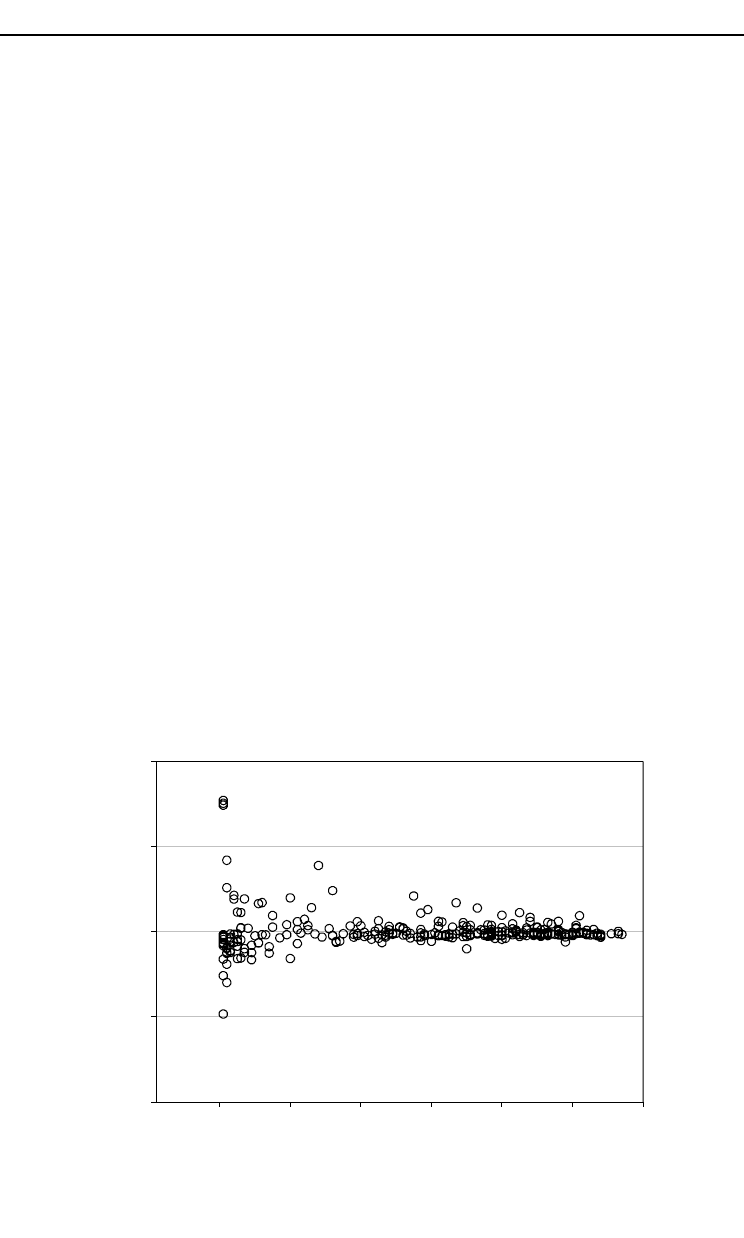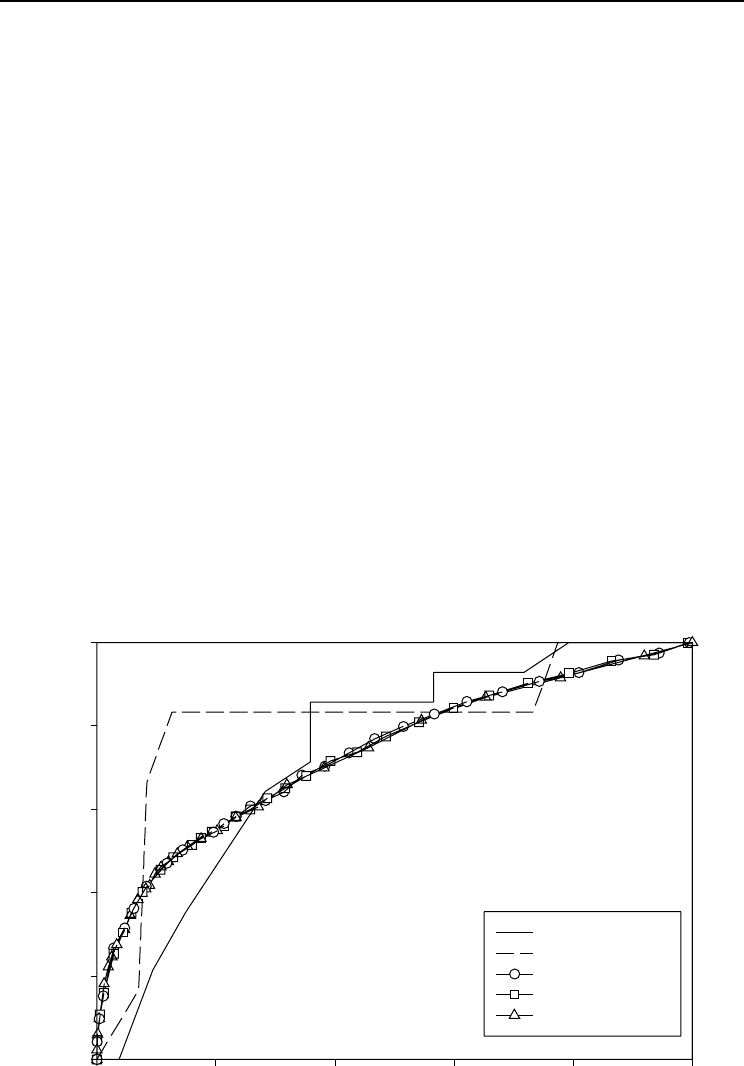Amaro A., Reed D., Soares P. (editors) Modelling Forest Systems
Подождите немного. Документ загружается.


23Amaro Forests - Chap 20 25/7/03 11:08 am Page 226
226 V. Alenius et al.
When modelling and classifying mortality it is necessary to determine to what
extent causality and regularities are taken into account and what phenomena are
regarded as stochastic. Subsequently, mortality can be classified as regular (non-
catastrophic) or irregular (catastrophic) (Vanclay, 1995). Regular mortality reflects
lowering vigour and decreasing growth rate, which may originate from ageing or
lack of resources and increasing competition and, as such, is at least partially pre-
dictable (Murty and McMurtrie, 2000). Irregular mortality is typically caused by
storms, forest fires, epidemics of pathogenes or insect population explosions, where
the survival probability is unpredictable at tree level but not necessarily at land-
scape level. Several logistic mortality models accounting for regular tree-level mor-
tality mainly due to competition have been developed (e.g. Monserud, 1976;
Hamilton, 1986; Avila and Burkhart, 1992; Monserud and Sterba, 1999; Shen et al.,
2000; Eid and Tuhus, 2001; Yao et al., 2001). Such models are mainly applied to con-
trol the predicted stocking level in stand simulators (e.g. Crookston, 1990; Botkin,
1993; Van Dyck, 2001; Hynynen et al., 2002).
It is common for individual tree mortality data to include several stands with
mor
e than one tree in each stand. As a consequence, the observations (trees in the
same stand) are always correlated. This fact has generally not been accounted for in
modelling individual tree mortality, although it calls for different methods of model
construction, and consequently leads to different procedures in parameter estima-
tion. Ignoring data structure in two- or more level mortality data leads to, for exam-
ple, too small standard errors for higher-level fixed effects which are measured at
plot or stand levels, a problem similar to any multivariate normal regression of
multilevel data. Therefore, when logistic regression is applied to multilevel data,
methods of analysis and measures of model fit which are appropriate especially for
these situations should be seriously considered. In this study, we compared logistic
mortality models for peatland Scots pine (Pinus sylvestris L.), which were developed
both with and without random stand effect and by alternative estimation methods
using two-level data. We discussed the methods of parameter estimation and the
use of different goodness-of-fit measures in the case of correlated data.
State of the Art
Traditional logistic regression
In logistic regression (Hosmer and Lemeshow, 2001), the dependent variable may be
binary or expr
essed in proportions. With the logit transformation, the linear model
is as follows
()
gx
1 −
π
()
αβ
x
(1)
()
= ln
π
x
=+
x
αβ
x
e
+
where
π
(x) =
,
α
is an intercept and
β
is a vector of unknown parameters.
+
1 + e
αβ
x
The distribution of the errors is supposed to be binomial with zero mean and vari-
ance
π
(x)[1
π
(x)]. The error term has two possible values: if E(y) = 1 then
ε
= 1
π
(x)
with probability
π
(x), and if E(y) = 0 then
ε
=
π
(x) with probability 1
π
(x). The
conditional distribution of y follows the binomial distribution with probability
given by the conditional mean,
π
(x).
The maximum likelihood (ML) method is used to estimate the parameters of
the logistic r
egression model, because the unknown parameters are non-linearly

23Amaro Forests - Chap 20 25/7/03 11:08 am Page 227
227 Logistic Regression in Modelling Mortality
related to
π
(x). The model’s statistical evaluation is done on the basis of several cri-
teria developed to guide in choosing the best model from different candidates.
Assessing the fit is usually done with the Pearson
χ
2
statistic and the deviance. The
Hosmer–Lemeshow test looks for the correctness of the model in grouping probabil-
ities in risk deciles. The classification table describes the model’s goodness of fit
with the correct classification rate. The receiver operating characteristic (ROC) curve
(Hosmer and Lemeshow, 2001) is based on sensitivity and specificity measures. A
high ROC curve describes the good prediction ability of the model. The area under
the curve is interpreted as the model’s R
2
.
Multilevel logistic regression with random effect
Multilevel logistic regression models for hierarchically structured data have become
mor
e common in recent studies of social sciences and medicine (e.g. Hox, 1995;
Goldstein and Rasbash, 1996; Carlin et al., 1999; Fielding, 2000). Forestry applica-
tions are few (Jalkanen, 2001), and published tree mortality models, for example,
have been constructed from multilevel data, but in parameter estimation the data
structure has been ignored.
Multilevel binary data can be analysed using a logistic regression model which
is composed of fixed covariates fr
om different hierarchy levels and random effects
(Hosmer and Lemeshow, 2001; McCulloch and Searle, 2001). The random effects not
related to the lowest level of hierarchy are generally assumed to follow normal dis-
tribution with mean zero and constant variance. Here the random stand effect
describes the unmeasured variance between the stands in case of mortality. The
error variance (tree-level variance) is assumed to be:
2
(2)
xl
π
x
φπ
()
(
−
()
)
where
φ
is the dispersion scale (or extra-binomial variance). If
φ
= 1, then the error
variance is purely binomial. If
φ
> 1, the situation is called over-dispersion. Unlike
under-dispersion (
φ
< 1), over-dispersion is fairly common, and may occur when
data are collected from experiments with a hierarchical design (McCullagh and
Nelder, 1989). If the dispersion scale is forced to be equal to 1, the potential over-
dispersed variance is added to the random effect variance.
The ML and restricted maximum likelihood (REML) methods are relevant
when analysing linear multilevel models with normal distribution, but logistic
r
egression models with random effects need special quasi-likelihood estimation
methods. The key point is to estimate the effect of the covariates on the binary out-
come with awareness of the random effect(s). The idea of quasi-likelihood methods
is that only the model for the mean (response and covariates) and the relationship
between the mean and the variance is necessary for the estimation. Two quasi-likeli-
hood methods have been developed for estimation: the marginal quasi-likelihood
(MQL) and the penalized quasi-likelihood (PQL) methods. Today these methods are
available in most statistical software packages. However, Rodriguez and Goldman
(1995) have pointed out that in certain circumstances the first-order MQL estimates
are badly biased, sometimes more biased than those obtained by ML without ran-
dom effects. The PQL method has also been noticed to have a major problem in
practice if the cluster size is small (McCulloch and Searle, 2001). Alternatives to the
ML approach are, for instance, GEE, generalized estimating equations (Zeger et al.,
1988) or Bayesian methods (MCMC, bootstrapping) (e.g. Goldstein, 1995; Browne
and Draper, 2002), which will not be addressed in this chapter.

23Amaro Forests - Chap 20 25/7/03 11:08 am Page 228
228 V. Alenius et al.
There is a basic problem with the goodness-of-fit measures in the case of multi-
level logistic regression; all tests based on likelihood are approximations, because
the likelihood is also an approximation. According to Hosmer and Lemeshow
(2001), many of the goodness-of-fit statistics have not been evaluated for hierarchi-
cal data, but they do recommend some of these tests instead of dismissing any
model checking.
Methodology
Multilevel model
In this study, the response variable is binary, i.e. the observed responses y
ij
of the tree
status may have two values: 0 = live or 1 = dead. With the standard assumptions of
the dependent variable, the distribution for the response is y
ij
∼
Bin(1,
π
ij
) with bino-
mial variance
π
ij
(1
π
ij
), where
π
ij
is the probability of the jth tree to die in stand i.
A two-level model with a random effect can be written in the general form:
gX
ij
,
βµ
i
)
= logit
()
=
β
+ X
ij
β
+ u
i (3)
(
ij
,
π
ij 0 ij
where
π
ij
is as above, term X
β
ij
is the component of the linear predictor, which has
ij
fixed coefficients (i.e. tree diameter at breast height, basal area of larger trees divided
by stand basal area, stand basal area, proportion of birch of total basal area, qua-
dratic mean diameter), and u
i
represents random departure from the average proba-
bility for a tree to die in the ith stand at logit scale. As stated earlier, the random
variable u is normally distributed with zero mean and variance σ
2
. The residual
u
error variance is a function of
π
ij
as in Equation 2.
Estimation
The log-likelihood function for the logistic regression with random effect is defined
as follows:
m
∞
n
y
ij
×
(
β
0
+ x
y
β
+u
i
)
2
1
π
σ
1
u
exp
−
2
u
σ
i
2
u
2
du
i
β
e
L
()
=
∑
∫
∏
1 + e
β
+ x
y
β
+u
(4)
0 i
i =1
−∞
j
For multilevel binary models, the quasi-likelihood method is attractive in para-
meter estimation due to its ability to generate highly efficient estimators
(McCulloch and Searle, 2001). The MQL method utilizes the score functions of log-
likelihood as the model for the mean and the model for the relationship between
mean and variance. This is not a very reasonable way to estimate the variance–
covariance matrix, because in the hierarchical collected data there is a correlation
between observations. In MQL this relationship between mean and variance is
based on an assumption of equal variance (simple variance–covariance structure),
which is not always reasonable. Goldstein and Rasbash (1996) showed that
improved estimation is obtained by applying the second-order PQL method, in
which the second-order Taylor expansion for the random part is calculated based
on current residuals u
i
with variance–covariance matrix D. The corresponding
equations for
β
are:
∂
MQL =
β
∑
Q
ij
= 0
∂
(5)
and

23Amaro Forests - Chap 20 25/7/03 11:08 am Page 229
229 Logistic Regression in Modelling Mortality
∂
′
− 1
PQL =
β
∑
Q
ij
−
1
u D u = 0 (6)
∂ 2
where Q
ij
is constructed using only information about how the variance changes as
u
ij
y
ij
− t
a function of the mean.
Q
ij
=
∫
τϑ
2
(
t
)
dt
, where
τ
is a constant of proportionality
y
ij
relating var(y
i
) to the linear predictor variance
ν
(
µ
i
).
To demonstrate the differences that result from ignoring the data structure in
the analysis, we first estimated the standar
d logistic regression model with maxi-
mum likelihood for 5-year mortality. In the multilevel analysis, first-order MQL and
second-order PQL methods (Goldstein and Rasbash, 1996) were used. The tree-level
error variance was also tested for over- and under-dispersion (Goldstein, 1995). All
parameters of the multilevel logistic models were estimated simultaneously. We
used
SAS (SAS Institute, 1994) and MLwiN (Goldstein et al., 1998) software to estimate
the models.
Goodness of fit
In traditional logistic regression, the difference between observed and fitted values
is measur
ed with Pearson residuals:
ˆ
ˆ
j
ry
j
,
π
j
)
=
(
y − m
j
π
j
)
(7)
ˆ ˆ
(
m
j
π
j
(
l −
π
j
)
where y
j
denotes the number of dead trees among m subjects with x
j
covariates. The
j
fitted values yˆ
j
= m
j
π
in logistic regression are calculated for every independent vari-ˆ
j
able and are called the covariate patterns m
j
j = 1, 2,…, J. The Pearson
χ
2
test is based
on adjusted residuals.
J
ˆ
2
X
2
=
∑
r y
j
,
π
j
)
(8)
(
j = 1
χ
2
– under the assumption that the fitted model is correct – follows
χ
2
distribu-
tion with degrees of freedom equal to J(p+1), where p is the number of
2
parameters. It should be noticed that in
χ
, y
j
is considered as a relative fre-
quency and m
j
is assumed to be large. One of the goodness-of-fit measures is
deviance, which is based on so-called adjusted deviance residuals. The differ-
ence between the likelihood of saturated and estimated models, the likelihood
ratio test, is equal to deviance and also follows
χ
2
distribution. However, it is only
an approximation.
The Hosmer–Lemeshow test groups the estimated probabilities from smallest to
lar
gest into groups (g), which are called the ‘deciles of risk’. The Hosmer–Lemeshow
goodness-of-fit C
ˆ
is based on the Pearson
χ
2
test from the g × 2 table of observed and
estimated expected frequencies:
2
g
(
O
k
− n
π
)
(9)
k k
ˆ
C =
∑
n
π
(
l −
π
k
)
k = 1
kk
where n
k
is the total number of subjects in the kth group, c
k
denotes the number of
c
k
covariate patterns in the kth group,
o =
∑
y
j
is the number of responses among c
k
k
j= 1

23Amaro Forests - Chap 20 25/7/03 11:08 am Page 230
230 V. Alenius et al.
ˆ
C
k
m
π
covariate patterns, and
π
k
=
∑
jj
is the average estimated probability. C
ˆ
is
j=1
n
k
approximated by the
χ
2
distribution with g 2 degrees of freedom. Evans (1998,
cited in Hosmer and Lemeshow, 2001) has shown that with some restrictions the test
can be applied to correlated data.
The classification table is an informative way to describe the results. The model
predicts the continuous probabilities; to convert these back to dichotomous results a
cutpoint (c) must be defined. If the estimated probability is less than c, the outcome
value is 0; otherwise it is 1. One way to determine the cutpoint is to choose it in such
a way that the rate of correct classification is maximized. The rate of correct classifica-
tion can be determined as the sum of the diagonal elements of the classification table
divided by the total number of observations.
Sensitivity and specificity can be obtained fr
om the classification table. These
measures describe how correct the model is in classifying dead and living trees.
Sensitivity is the frequency of observed ‘1’ which the model predicted as ‘1’ divided
by all observed ‘1’. Specificity is the frequency of observed ‘0’, which the model has
predicted as ‘0’, divided by all observed ‘0’. Evaluating the cutpoint in such a way
that sensitivity and specificity are as high as possible, the estimated probabilities in
risk deciles frequency should have large frequencies close to 0 and 1. Sensitivity and
specificity form the basis of describing the model’s ROC curve, which is drawn as
sensitivity against (1specificity) with all possible cutpoints. The height of the curve
describes the model’s ability to predict the phenomenon. The area under the curve
represents the model’s R
2
.
We calculated
χ
2
, the classification table, specificity, sensitivity, bias, the
Hosmer–Lemeshow test, ROC curves and R
2
as the basis of evaluation and dis-
cussed their use for this purpose in multilevel data. The bias was calculated in two
ways: (i) tree-level bias as the average difference of tree-level mortality observations
and predictions, and (ii) stand-level bias as an average difference of stand-level
observed and predicted mortalities.
Data
We used the permanent peatland growth plots (SINKA) as the modelling data. The
SINKA stand is composed of a cluster of three circular plots located 40 m apart. In
order to avoid too-laborious measurements in dense sapling stands, the radii of the
circular sample plots were adjusted according to the stand density in such a way
that the whole SINKA cluster contained approximately 100 tally trees. For those, the
minimum diameter at breast height (DBH) was 4.5 cm if the stand was past pole
age, and 2.5 cm otherwise. The first re-measurement of the SINKA data was done in
1988–1994 following a period of five growing seasons on each plot. For a more
detailed description of the data, see, for example, Hökkä et al. (1997). From the struc-
ture of the data, it is clear that trees within stands are correlated.
For the purposes of this study, both pure Scots pine and mixed pine–birch
stands (an admixtur
e of Betula pubescens Ehrh.) were included in the data if at least
one pine was present in the cluster. The data were restricted to stands where no
management operations (thinning, ditching) had been carried out during the last
5-year period preceding the first measurement or between the measurement occa-
sions. Altogether, the numbers of stands and trees were 295 and 17,293, respec-
tively. The mortality proportion for pine was 2.73%. The average tree DBH for

23Amaro Forests - Chap 20 25/7/03 11:08 am Page 231
231 Logistic Regression in Modelling Mortality
pine was 9.1 cm (range 2.5–44.5 cm). The proportion of large trees in the data was
low; there were only 27 pines with DBH larger than 30 cm.
Results and Discussion
Model assumptions and estimation methods
In the basic logistic regression approach without random variable (ML), the
assumption of independent r
esiduals was violated. This can be seen in the lower
values of the standard errors of stand-level variables compared with those of the
multilevel models (Table 20.1). The parameter estimates were not far from those of
the multilevel models, the greatest difference being in the coefficients of DBH
1
and
DW (18% and 16% underestimates compared with the MQL estimates, but the dif-
ference was non-significant when the standard errors were considered). In the MQL
estimation, the tree-level variable DBH
1
influenced mortality more when com-
pared with the basic logistic regression, while the opposite was true with the stand-
level variables. The variance component related to the between-stand variation in
mortality was clearly significant in all multilevel models. The advantage of the
model with random effect (MQL and PQL) is that the model can be calibrated to a
specific stand, if mortality from the preceding 5-year period has been observed (see
McCulloch and Searle, 2001). For a more detailed description of the construction
and interpretation of the models, see Jutras et al. (2003).
For the multilevel models, the MQL and PQL estimation methods also showed
somewhat dif
ferent results (Table 20.1). There was no problem of convergence with
PQL, which has been the case in many other studies. In our data, PQL estimates in
the fixed part were always larger than MQL estimates, but the difference was statis-
tically significant only for G, stand basal area (m
2
/ha). The opposite was true for the
random stand effect. This suggested that with MQL, less variation was accounted
for by the fixed part. With MQL, minor overdispersed variation was detected. When
the scale effect was fixed at 1 in MQL, the overdispersed variance was transformed
to the between-stand variance. With PQL, the assumption of binomial variance
appeared to be valid in our data.
Table 20.1. Models for peatland Scots pine mortality estimated by different methods. Standard errors
are given in parentheses.
Models
1st order MQL, 2nd order PQL,
ML, without with extra with extra
Variables
a
random effect 1st order MQL dispersion 2nd order PQL dispersion
Constant 5.719 (0.307) 5.855 (0.465) 4.515 (0.227) 6.808 (0.515) 6.808 (0.515)
DBH
–1
30.884 (10.553) 37.64 (12.78) 37.155 (13.356) 42.1 (14.731) 42.098 (14.736)
BALRAT 2.091 (0.319) 2.020 (0.355) 2.027 (0.373) 2.137 (0.403) 2.137 (0.403)
G 0.111 (0.010) 0.107 (0.022) 0.108 (0.021) 0.132 (0.023) 0.132 (0.023)
G_B 2.133 (0.231) 2.007 (0.435) 2.011 (0.434) 2.170 (0.474) 2.170 (0.474)
DW 0.128 (0.024) 0.110 (0.043) 0.112 (0.043) 0.125 (0.046) 0.125 (0.046)
σ
u
2
1.985 (0.231) 1.842 (0.197) 1.579 (0.251) 1.579 (0.251)
Dispersion 1.000 (0.000) 1.000 (0.000) 1.112 (0.012) 1.000 (0.000) 1.001 (0.011)
scale
φ
a
DBH
1
, tree diameter at breast height (mm); BALRAT, basal area of larger trees/stand basal area; G,
stand basal area, (m
2
/ha); G_B, proportion of birch of total basal area (%); and DW, quadratic mean
diameter (cm).

Browne and Draper (2002) pointed out that in many cases both MQL and PQL
methods produce clearly biased parameter estimates, PQL being generally more rec-
ommendable than MQL. Differences in estimates became evident in situations
where the number of observations within clusters was small (see McCulloch and
Searle, 2001). According to Goldstein and Rasbash (1996), the low number of obser-
vations at the lowest level and especially the ratio of the level-1 units to level-2 units
may be the main source of bias in estimates. It is clear that with few observations the
estimation of covariance parameters is unstable. This is also the case with PQL, as
shown by Browne and Draper (2002). In our data, the ratio (average number of trees
in stand : number of stands) was 59 : 295, and was probably sufficient, since all the
methods appeared to give parameter estimates that were close to each other. Figure
20.1 illustrates the effect of cluster size on estimates with the help of the difference of
stand-wise-calculated average mortality and corresponding predicted probability.
Figure 20.1 shows that when the number of trees per stand is less than 30, there is
large variability in residuals. When there are fewer than 10 trees per cluster, the
residuals may be anything between 0.0 and ±0.8. In a way this is trivial in data
where the average probability is low, because for clusters with a low number of
observations, one tree is representing high relative proportion in such clusters. The
model, however, predicts low probabilities in these stands, too.
Another factor that has been assumed to influence the first-order MQL esti-
mates is the magnitude of the higher-level variance. This was not a problem with
our data either, despite the fact that the two-level variance was relatively high
(1.6–2.0) compared with the value of 0.5 which Rodriguez and Goldman (1995) and
Goldstein and Rasbash (1996) gave as the limit for large variance.
In cases where PQL and MQL appear to give biased results, both Goldstein
(1999) and Browne and Draper (2002) suggest the use of Bayesian methods.
However, these are computationally much more demanding (Browne and Draper,
2002).
232 V. Alenius et al.
Number of trees in stand
0 20406080100120
–1.0
–0.5
0.0
0.5
1.0
Stand-level residual
Fig. 20.1. Stand-level mortality residuals (average observed mortality in the stand – average predicted (MQL
method) probability) as a function of the number of trees in the stand.
23Amaro Forests - Chap 20 25/7/03 11:08 am Page 232

23Amaro Forests - Chap 20 25/7/03 11:08 am Page 233
233 Logistic Regression in Modelling Mortality
Fitting measures
The logistic regression goodness-of-fit measures are generally based on Pearson
r
esiduals and deviance. They can be used only with the assumption of the indepen-
dence of observations. In hierarchical data, the residuals are correlated in clusters,
i.e. stands, so these fitting measures are biased and may be used only for specula-
tion. T
able 20.2 shows a lot of instability in the Pearson
χ
2
test among different mod-
els. As discussed by Hosmer and Lemeshow (2001), Evans (1998) has improved the
Pearson
χ
2
test to make it applicable to correlated data, but we are not able to con-
sider it in more detail here.
The classification table can be used as an overall measure of goodness-of-fit also
in cases of corr
elated data, since it is not affected by the data structure. The result of
the ordinary Hosmer–Lemeshow test is not reliable because it is assuming indepen-
dence among the observations. According to the results, these models did not fit
into the data.
Our multilevel mortality models appeared to be more specific than sensitive.
Sensitivity was highest with ML, followed by MQL, and lowest with the PQL
method. Mortality models need to be sensitive, i.e. mor
e accurate, to find dead trees
than living ones. With all models there were always some living trees predicted as
dead. With PQL, the rate of correct classification was highest (73%), but it predicted
Table 20.2. Goodness-of-fit measures calculated on the basis of the fixed part of the models.
Models
Measure of fit ML 1st order MQL 2nd order PQL
Pearson X
2
15149.87 19079.26 17306.53
Hosmer–Lemeshow 44.7 45.1 233.9
P value χ
2
8
(<0.0001) (<0.0001) (<0.0001)
Sensitivity (%) 73.7 64.2 60.2
Specificity (%) 56.2 69.1 73.5
Rate of correct 56.7% 68.5% 73.1%
classification
Area under the ROC 0.7434 0.7462 0.7291
curve (R
2
)
Tree-level bias +0.00031 0.00104 +0.01105
Relative (%) +1.1 -3.8 +40.5
Stand-level bias +0.001572 +0.001392 +0.01901
Relative (%) +3.0 +2.8 +36.5
Tree-level bias :
ˆ
∑
(
y
−
π
ij
)
ij
bias
j
=
N
where y
ij
= tree j status, 0 or 1 in stand i;
π
ij
= predicted probability that tree j in stand i will die; and N =
total number of tree observations.
Stand-level bias :
−
ˆ
i
∑
(
YY
i
)
bias
i
=
S
ˆ
ij
where Y
i
= observed mortality in stand i,
∑
y
; Y
ˆ
i
= predicted mortality in stand i,
∑
π
ij
; S = total
n
i
n
i
number of stands in data; and n
i
= total number of trees in stand.

23Amaro Forests - Chap 20 25/7/03 11:08 am Page 234
234 V. Alenius et al.
living trees more accurately than dead ones, resulting in clearly lower sensitivity
than ML and MQL. With MQL, the rate of correct classification was 68%, but it pre-
dicted dead trees more accurately than the PQL method.
The ROC curve can also be used to select the best model in correlated data,
because it is based on sensitivity and specificity
. Visually, the curves differed
upwards from the 45° straight line, indicating that the models had rather good abil-
ity to predict tree mortality, but there was virtually no difference among curves (Fig.
20.2). However, the area under the curve (R
2
) was highest for the MQL method and
lowest for the PQL method (Table 20.2). This suggested that the model obtained by
the MQL method had the highest discrimination ability. Stand-wise-calculated ROC
curves illustrated the model’s (MQL) ability to predict dead trees in specific stands
in the data (Fig. 20.2).
The logistic model (ML) without random effect gave the lowest tree-level bias,
which is to be expected because it is a population average model and should work
well mar
ginally. The stand-level bias was lowest for the MQL method, which is a
cluster-specific model accounting for the hierarchical data structure and should
work well at cluster (stand) level.
In general, to be chosen as the best model, all measures need to be good. The
MQL
and ML methods appeared to result in models with good fit measures, accept-
able bias and high R
2
. Because the MQL method is theoretically correct, the corre-
sponding model should be chosen. The reasons for the poor performance of the PQL
model remain unclear, but the result is not necessarily unusual (see discussion in
McCulloch and Searle, 2001). Here it may be partly due to the strongly skewed data,
with low overall mortality.
Sensitivity
1.0
0.8
0.6
0.4
0.2
0.0
Stand 864 (MQL)
Stand 33 (MQL)
MQL-method
Logistic model
PQL-method
Stand 33
Stand 864
0.0 0.2 0.4 0.6 0.8 1.0
1-Specificity
Fig. 20.2. T
he average ROC curves of different models. Additional curves are drawn for two example
stands, 33 and 864 (on the basis of the MQL method).

23Amaro Forests - Chap 20 25/7/03 11:08 am Page 235
235 Logistic Regression in Modelling Mortality
Conclusions
Our results suggest that with relatively balanced data the marginal quasi-likelihood
(MQL) method produced consistent model estimates for multilevel binary mortality
models. However, the model’s goodness-of-fit is problematic to measure in corre-
lated binary data. The classification tables, specificity, sensitivity, correct classifica-
tion rate, bias and R
2
may be used to evaluate the model’s performance. Applying
the traditional Hosmer–Lemeshow statistics cannot be recommended. Here the test
suggested rejection of all models, although the models produced by the ML and
MQL methods behaved well in terms of sensitivity, the correct classification rate,
and bias. Compared with the other measures, which actually measure the marginal
performance of the models, the ROC curve analyses the predicted probability distri-
bution, and thus is better at describing the variability in the predictions. The graphi-
cal expression did not give additional information to make a selection among the
models, but the R
2
showed that the models obtained by the ML and MQL methods
were slightly better than that obtained by the PQL method.
When the binary multilevel models are applied, the continuous outcome pre-
dicted by the fixed part is back-transformed into binary values. If the overall cut-
point is applied, the data str
ucture will not be utilized in selecting ‘1’s and ‘0’s.
However, in stand simulators the model can be used in a deterministic way
(Hynynen et al., 2002). The stem frequencies of each DBH class will be decreased by
the amount of the predicted continuous mortality probability, i.e. it is not necessary
to specify a cutpoint and determine which individual will die.
Acknowledgement
We wish to thank Dr Juha Lappi for his valuable comments.
References
Avila, O.B. and Burkhart, H.E. (1992) Modeling survival of loblolly pine trees in thinned and
unthinned plantations. Canadian Journal of Forest Research 22, 1878–1882.
Botkin, D.B. (1993) Forest Dynamics: an Ecological Model. Oxford University Press, Oxford,
309 pp.
Browne, W.J. and Draper, D. (2002) A comparison of Bayesian and likelihood methods for fit-
ting multilevel models. Journal of the Royal Statistical Society, submitted.
Carlin, J.B., Wolfe, R., Coffey, C. and Patton, G.C. (1999) Analysis of binary outcomes in longi-
tudinal studies using weighted estimating equations and discrete time survival methods:
prevalence and incidence of smoking in an adolescent cohort. Statistics in Medicine 18,
2655–2679.
Crookston, N.L. (1990) User’s Guide to the Event Monitor: Part of Prognosis Model Version 6. USDA
Forest Service, Intermountain Research Station, Odgen, Utah, General Technical Report
INT-275, 21 pp.
Dobbertin, M. and Biging, G.S. (1998) Using the non-parametric classifier CART to model for-
est tree mortality. Forest Science 44, 507–516.
Eid, T. and Tuhus, E. (2001) Models for individual tree mortality in Norway. Forest Ecology and
Management 154, 69–84.
Evans, S.R. (1998) Goodness-of-fit in two models for clustered binary data. PhD thesis,
University of Massachusetts at Amherst, Amherst, Massachusetts, 145 pp.
Fielding, A. (ed.) (2000) Generalized Linear Mixed Models in Multilevel and Other Complex Data
Structures in the Social Sciences. Social Science Methodology in the New Millennium.
